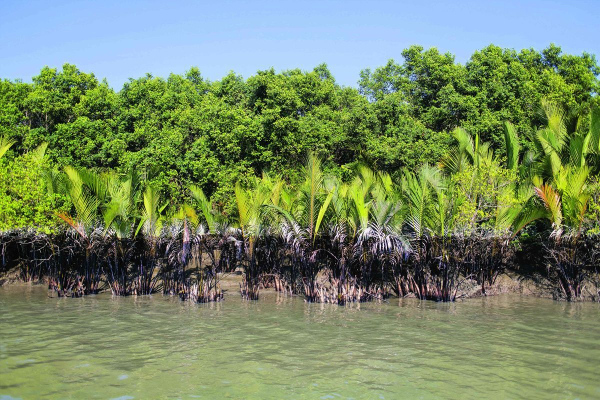The Sunderbans, the largest mangrove forest in the world and home to the Royal Bengal Tiger, has once again come to Kolkata’s rescue, saving the 300-year-old city from the wrath of the severe cyclone, Bulbul, that killed at least eight people and left a trail of destruction in its wake.
In May 2009, the mangrove forest saved the city from the impact of cyclone Aila.
“The Sunderbans with its thick mangrove forest acts like a shield. The mangroves do not just help to reduce the wind speed drastically when the storm moves through the delta but even help to break the waves and the storm surge triggered ,” said Sugata Hazra, professor at School of Oceanographic Studies in Jadavpur University.
The Sunderbans spans 10,000 sq km across India and Bangladesh, of which 40% is in India, and is home to many rare and globally threatened wildlife species such as the Royal Bengal Tiger and the estuarine crocodile. In India, it is confined to the southern tip of West Bengal and spreads over two districts, South 24 Parganas and North 24 Parganas.
“Any cyclone, which originates in the Bay of Bengal and hits the West Bengal coast, has to pass through this mangrove forest before it can hit Kolkata. The mangrove, with its almost impenetrable and thick mesh of trees and roots, acts as a wind barrier, absorbing much of the storm’s steam and leaving it ineffective, in turn, saving Kolkata,” said Pranabesh Sanyal, former chief wildlife warden and ex-chief environment officer of West Bengal.
He also said that the location and curvature of the Sunderban delta is such that in most cases the cyclones are diverted towards Bangladesh after they hit the mangroves. This time too, cyclone Bulbul headed towards Bangladesh after it hit the delta.
“The Sunderbans has proved its worth again. Many areas such as Sagar, Mousuni, Frazergunj and Bakkhali where human settlements have come up after clearing the mangroves have suffered extensive damage. The damage is relatively less in the eastern part of the delta where there is thick mangrove,” said Abhijit Mitra, a marine scientist and a former professor of Calcutta University.
The Sunderbans itself has been ravaged by humans, though. Out of the 102 islands, 54 have human settlements; the rest have forests with national parks, reserve forests and sanctuaries which are home to the only mangrove tigers in the world. It is in these human habitats that the mangroves have suffered the maximum loss over the years.
“Illegal felling of trees outside the forest area for timber, infrastructure development, construction of hotels and resorts and farming has taken a heavy toll on the mangroves. The mangrove cover has depleted over the years. Of late because of the intervention of the national green tribunal and courts this has come down a bit. A few construction activities were also stalled as they were violating the coastal regulation zone rules,” said Subhash Acharya, former joint director of the Sunderban Development Board.
According to the Forest Survey of India’s State of Forest Reports, which are published every two years, the very dense mangrove cover, which actually acts as the barrier against such storms, has shrunk from 1,038 sqkm in 2011 to 999 sqkm in 2017 (the latest report). Similarly, moderately dense forest cover has shrunk from 881 sqkm to 692 sqkm during the same period.
It is only the open mangrove cover that has increased marginally — because of plantation and natural regeneration of mangrove on some islands. Between 2015 and 2017, only around eight sqkm of mangrove has been added.
“The mangrove has saved us. The forest department and the gram panchayats and the Sunderban affairs department have been planting mangrove trees extensively on the island and the river’s embankments. The mangrove (cover) is now increasing,” said Manturam Pakhira, Sunderban affairs minister.
Mumbai’s mangroves, spread across 8,000 hectares (6,400 hectares of government land and 1,600 hectares of private land), too, have been under threat from real estate development and infrastructure projects despite being the first line of defence against storms and increasing sea level.
In 2019 alone, Mumbai has witnessed 75 cases of mangrove destruction. While 14 people were arrested and let out on bail, not a single conviction has been recorded so far. The destruction of mangroves was banned by the Bombay high court through an order on September 18, 2018, and all government agencies and private companies have been directed to hand over mangrove land to the forest department for better protection.
Source: HT
Image Courtesy: SAEVUS
You may also like
-
India Can’t Afford to Remain Stagnant at this Juncture, Says PM Modi; Asks People to Buy Locally-Made Goods
-
Stolen Artefacts to be Returned to India from Scotland Museums
-
Netaji’s Hologram Statue at India Gate
-
10th Century Stone Idol of Goat Head Yogini IllegallyRemoved from A Temple in Lokhari, Banda, UP Being Returned to India
-
UNESCO Inscribes ‘Durga Puja in Kolkata’ on the Representative List of Intangible Cultural Heritage of Humanity
